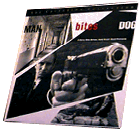

France action
1993
color 95 min.
Director: Remy Belvaux, Andre Bonzel, Benoit Poelvoorde
CLV: $49.95 - available
1 disc, catalog # CC1367L
"It's not a film about violence; it's a film about filmmaking," claims André Bonzel,
one of the three filmmakers responsible for Man Bites Dog. Despite Bonzel's assertion, at first
glance this very successful film seems to be just another violent boys' movie, part of a
group of independent films by first-time directors made in the early '90s that revised various generic conventions
in order to push to extremes spectators' tolerance for brutalized bodies. From the opening
shot of a train passenger's strangulation through the 30 or so murders that follow, the
film has all the requisite cool and violent excess characterizing the independent hits of 1993.
Yet, Bonzel is right: The film is not just about violence -- it is about filmmaking, and
film viewing.
Shot with a hand-held camera and black-and-white stock, the film documents the exploits of a killer, Ben,
in a style paying homage to the work of cinema verité proponent Jean Rouch. Rouch claimed
that the garnering of truth on film requires the filmmakers' onscreen involvement with their subjects. Thus,
from the beginning of Man Bites Dog, the film crew's presence is acknowleged as they ask
questions, make comments, and respond to Ben. The interaction between the filmmakers and their subject steadily
increases such that Ben is soon directing the action and paying
for film stock and the filmmakers are carrying bodies and helping hold down victims. The line between the
filmmakers and subject has been dissolved -- Rouch would be proud.
But Man Bites Dog is not a documentary, and this fact ripples throughout the rest of the film. Secure
that the images on screen are not real, we are quite content to tolerate almost anything; the images are somehow
sanctioned. Because this is not a documentary, Ben's brutality is humorous rather than appalling, the filmmakers
are endearing for their sincere efforts rather than demented, and the film seems to be a slick parody of documentary
style and audience gullibility.
But Man Bites Dog is not just a simple parody either. Instead, through the manipulation
of spectator identification and the straddling of the line between the filmic and profilmic, the film
causes an extraordinarily unnerving recognition of spectator complicity. The filmmakers spark
this remarkable insight through very subtle manipulations of their material; it only comes
after we have been completely drawn into identifying with the filmmakers.
This process begins with a scene in a bar in which Ben demonstrates how to make a Dead Baby Boy,
a drink which featuress an olive that, like Ben's innumerable victims dumped in the water-filled quarry,
slowly rises from the bottom of the glass in a flurry of bubbles. We view the drinks from the crew's
point of view, close-up on the olives in the
shimmering gin. Like Rémy and André in the film, we marvel at the incredible beauty of the
"dead baby boy" and the sublime ability of film stock to capture something so simple and marvelously
beautiful. We are primed, then, to praise the merits of cinema with the filmmakers, who stumble
drunkenly from the bar singing, "Cinema, cinema..."
But before we can catch our breath, we are bursting through someone's door, assaulting a
naked woman, and participating in rape. Ben and the crew take turns between the victim's legs,
with the camera and sound equipment being clumsily handed back and forth. The space
between the action and its recording has collapsed, and our pleasure in watching the
images with the security that this is fiction turns to horror as we suddenly realize that it does not
really matter. We have been enjoying ourselves. It is at this moment that we recognize our complicity
as spectators in the spectacle that we are viewing. We are as much present in and responssible for this ode to
cinema as the characters onscreen.
Perhaps due to this insight, Man Bites Dog sparked tremendous controversy upon its release. Exhibitors
in various countries felt compelled to censor something -- the French altered the film's one-sheet, changing
the pacifier floating above a splash of blood to false teeth, replacing the horror of child-killing with the apparently
more acceptable horror of executing the elderly. The Italians chose complete discretion and removed both
objects, leaving the implied victim anonymous. American exhibitors were most nervous and chose to completely
cut the rape scene from the film, effectively negating the film's fundamental objective. The film was also
assailed for its brutality, a criticism that completely misses the film's point, summed up simply
by Bonzel: The film is not about violence, but about filmmaking.
-- Holly Willis
Credits
Directed by: Rémy Belvaux
Produced by: Rémy Belvaux, André Bonzel, and Benoit Poelvoorde: Les Artistes Anonymes
Screenplay by: Rémy Belvaux, André Bonzel, and Benoit Poelvoorde
Camera by: André Bonzel





